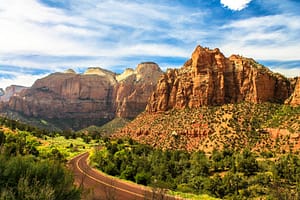Mormon pioneer Issac Behunin built the first log cabin in Zion Canyon in 1863, near the location of the current Zion Lodge. Behunin Canyon, a technical slot canyon, was named after him. During the remainder of the century, small communities and homesteads in the area struggled to survive. Pioneers gave the canyon the name “Zion”, a Hebrew word meaning safety, or a place of refuge. Despite the name, the canyon offered little arable land, poor soil, and catastrophic flooding, making agriculture a risky venture.
By the first decade of the 20th century, the scenic qualities of southern Utah, and Zion Canyon in particular, had been recognized as a potential destination for tourism. In 1909, a presidential executive order designated Mukuntuweap National Monument. The new monument was, however, virtually inaccessible to visitors, since the existing roads were in poor condition and the closest railhead was a hundred miles away. The monument’s name was changed to Zion National Monument in 1918, and in 1919 the monument was expanded and designated a national park. Visitation to the new national park increased steadily during the 1920s, and in 1930, the newly completed Zion-Mt Carmel Highway allowed motorists to travel through the park to Mount Carmel Junction, then on to Bryce Canyon and the Grand Canyon. This highway was one of the greatest engineering feats of modern times, requiring the construction of a 5,613-foot tunnel, the Zion-Mt. Carmel Tunnel, to negotiate the vertical sandstone cliffs of Zion. The switchbacks leading up to the tunnel proved to be an even greater task to accomplish. The Kolob Canyons section, near Cedar City was established as a National Monument in 1937 and added to Zion National Park in 1956.
Although Zion is in an arid desert climate, the park has almost nine-hundred native species of plants, seventy-five species of mammals, two-hundred-ninety species of birds including the recent addition of the California Condor, forty-four species of reptiles and amphibians and eight native fish.
Mammals commonly found within the park’s borders include bats, jack rabbits, chipmunks, squirrels, gophers, kangaroo rats, beavers, mice, porcupines, coyotes, gray fox, ringtails, skunks, mule deer and the rarely seen mountain lions. Peregrine falcons, rattlesnakes and numerous lizards are also species that visitors may recognize.
There is a wide variety of plant life in the park, seeing that the unique geology has created diverse environments such as deserts, canyons, slickrock, hanging gardens, riparian, and high plateaus. There are many beautiful wildflowers, including the Sacrad Datura, which is common in Zion and is often found along the Zion-Mt. Carmel Highway and on the canyon floor in Zion Canyon.

